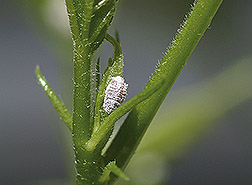Mealybugs
| Mealybugs | |
|---|---|
 | |
| Type: | Insect |
| Family: | Pseudococcidae |
| Order: | Hemiptera |
| Metamorphosis: | Incomplete |
| Damaging stages: | All |
| Vulnerable stages: | All |
Mealybug is the common name of insects in Pseudococcidae, a family of unarmored Scale Insects found in moist, warm climates. They feed on plant juices of greenhouse plants, house plants and some outdoor plants.
Description
[edit | edit source]Mealybugs are sexually dimorphic, meaning that the sexes have distinct morphological differences. Females are nymphal, exhibit reduced morphology, and are wingless. The females do not change completely and are likely to be neotonic (exhibiting nymphal characteristics). Males are winged and do change completely during their lives. Since mealybugs (as well as all other Hemiptera) are hemimetabolous insects, they do not undergo complete metamorphosis in the true sense of the word. I.e. there are no clear larval, pupal and adult stages, and the wings do not develop internally. However, male mealybugs do exhibit a radical change during their life cycle, changing from wingless, ovoid nymphs to "wasp-like" flying adults.
Symptoms and Signs
[edit | edit source]Large infestations may induce leaf drop.
Ecology
[edit | edit source]Mealybug females feed on plant sap, normally in roots or other crevices. They attach themselves to the plant and secrete a powdery wax layer (therefore the name mealybug) used for protection while they suck the plant juices. The males on the other hand, are short-lived as they do not feed at all as adults and only live to fertilize the females. Male citrus mealy bugs fly to the females and resemble fluffy gnats.
Some species of mealybug lay their eggs in the same waxy layer used for protection in quantities of 50–100; other species are born directly from the female.
The most serious pests are mealybugs that feed on citrus; other species damage sugarcane, grapes, pineapple (Jahn et al. 2003), coffee trees, cassava, ferns, and orchids. Mealybugs only tend to be serious pests in the presences of ants because the ants protect them from predators and parasites. Mealybugs also infest some species of carnivorous plant such as Sarracenia (pitcher plants), in such cases it is difficult to eradicate them without repeated applications of insecticide such as Diazinon. .
Species
[edit | edit source]Control
[edit | edit source]References
[edit | edit source]- Jahn, G. C. and J.W. Beardsley 1998. Presence / absence sampling of mealybugs, ants, and major predators in pineapple. J. Plant Protection in the Tropics 11(1):73-79.
- Jahn, Gary C., J. W. Beardsley and H. González-Hernández 2003. A review of the association of ants with mealybug wilt disease of pineapple. Proceedings of the Hawaiian Entomological Society. 36:9-28.
